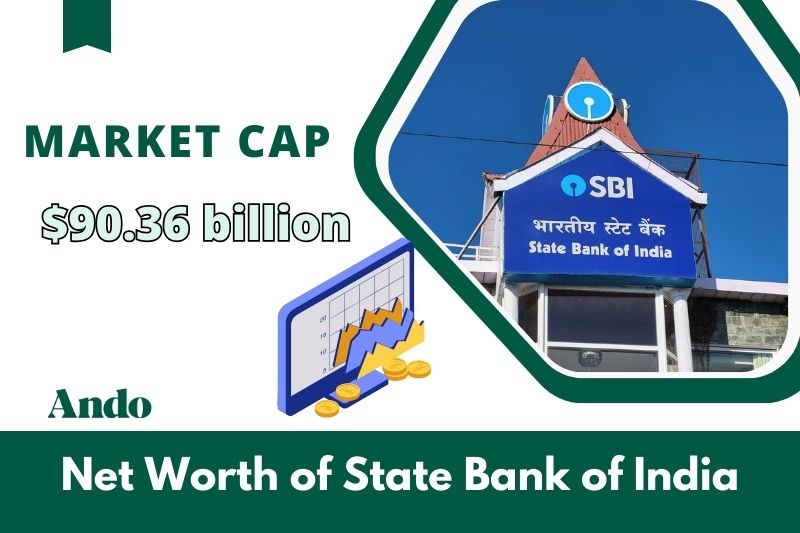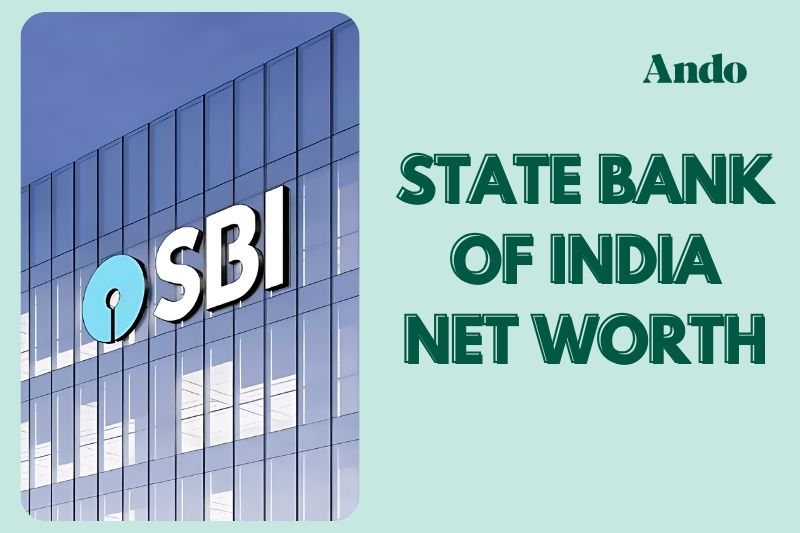Discover the State Bank of India net worth in 2024 with Ando Money. Dive into a detailed analysis of SBI’s financial performance, market cap, and global standing.
Quick Facts
| FACT | DETAIL |
|---|---|
| Name | State Bank of India |
| Full Name | State Bank of India |
| Traded as | NSE: SBIN, BSE: 500112 |
| ISIN | INE062A01020 |
| Founded | 1 July 1955 |
| Founders | Government of India |
| Country/Territory | India |
| Headquarters | Mumbai, Maharashtra, India |
| Chief Executive Officer | Dinesh Kumar Khara |
| Number of Employees | 232,296 |
| Market Cap | ₹7.53 trillion ($90.36 billion) |
| Total Assets | ₹61.79 trillion ($740.76 billion) |
| Total Equity | ₹3.76 trillion ($45.12 billion) |
| Revenue | ₹4.39 trillion ($53 billion) (2024) |
| Net Income | ₹61,077 crore ($732.92 million) |
What is the Net Worth/ Market Cap Of State Bank of India in 2024?

The net worth of the State Bank of India (SBI) reflects its substantial financial health and market presence.
As of 2024, SBI boasts a market capitalization of ₹7.53 trillion ($90.36 billion). This positions SBI as a dominant player in the global banking sector.
For comparison, Japan Post Bank has a market cap of $33.98 billion, and China Minsheng Bank stands at $21.55 billion.
Clearly, SBI outpaces these significant international banks, showcasing its robust financial stature and influence.
The comprehensive strength of SBI’s financial assets, extensive domestic and international reach, and a broad customer base underlines its pivotal role in the banking industry.
State Bank of India Financial Performance Overview

Understanding the financial performance of the SBI involves looking at various critical indicators that contribute to its revenue and overall financial health.
Key Financial Indicators
Several financial indicators highlight SBI’s robust financial position. These include:
- Total Assets: SBI’s total assets amount to ₹61.79 trillion ($740.76 billion), underscoring its vast resource base.
- Deposits: The bank has accumulated deposits worth ₹49.16 trillion ($589.92 billion), reflecting high customer trust and stability.
- Advances: The advances stand at ₹37.68 trillion ($452.16 billion), indicating a strong lending portfolio.
- Net Interest Income: With a net interest income of ₹1.59 trillion ($19.08 billion), SBI shows effective revenue generation from its core banking operations.
- Profit After Tax (PAT): The profit after tax is ₹61,077 crore ($732.92 million), showcasing significant profitability.
Contributions to Revenue
SBI’s revenue streams are diverse and robust, contributing to its strong financial standing.
Loan Portfolio and Interest Income
A significant portion of SBI’s revenue comes from its loan portfolio. The interest income generated from personal loans, home loans, and corporate loans forms the backbone of its financial performance.
Fee Income from Banking Services
Another major revenue stream is the fee income from various banking services, including account maintenance fees, transaction fees, and other service charges.
Income from Investments
SBI’s investments in securities and other financial instruments also contribute significantly to its revenue.
Digital Banking Services
The digital platform YONO has revolutionized banking for SBI. With millions of users, YONO’s convenience drives significant revenue through transaction fees and service charges.
Market Position and Competitive Advantage
SBI holds a dominant position in the Indian banking sector with a substantial market share.
Its extensive network of branches and ATMs across India, especially in rural areas, provides a competitive edge.
In the global arena, SBI’s presence in 29 countries with 241 overseas branches showcases its international reach.
- Market Share: In India, SBI commands a market share of 22.55% in deposits and 19.06% in advances. This dominance is a testament to its extensive customer base and trustworthiness.
- International Presence: SBI’s strategic international branches contribute to its revenue, particularly from foreign currency loans and trade finance.
Impact of Technological Innovations
- Digital Transformation: Increased efficiency and customer satisfaction through YONO, SBI’s flagship digital platform.
- Investment in AI/ML: Enhances service delivery, fraud detection, customer service, and personalized banking, boosting revenue.
Corporate Governance and Risk Management
- Corporate Governance Structure: Ensures accountability and transparency through the Board of Directors.
- Risk Management Practices: Maintains financial stability with rigorous credit assessments, liquidity management, and regulatory compliance.
- Regulatory Compliance: Adherence to Reserve Bank of India guidelines ensures reliability and trustworthiness.
Sustainability and Corporate Social Responsibility (CSR)
- Green Initiatives: Investments in green energy and sustainable practices enhance the corporate image.
- CSR Activities: Focus on education, healthcare, and community development, with ₹502.32 Crore allocated.
- Environmental and Social Governance (ESG): Balances financial performance with social responsibility.
Economic Factors Influencing Performance
Several economic factors influence SBI’s financial performance.
- Indian Economic Growth: The growth of the Indian economy has a direct impact on SBI’s performance. As the economy expands, the demand for banking services increases, boosting SBI’s revenue.
- Government Policies: Policies aimed at financial inclusion, infrastructure development, and economic reforms benefit SBI. These policies create opportunities for lending and investment, driving revenue growth.
- Global Economic Conditions: Global economic trends also affect SBI’s performance, particularly through its international branches. A stable global economy enhances trade finance and foreign investments, contributing to SBI’s revenue.
Future Growth Prospects
SBI’s future growth looks promising, with several strategic initiatives underway.
- Strategic Initiatives: Plans to expand both domestically and internationally, coupled with the introduction of innovative financial products, will drive future growth.
- Technological Developments: Continued investment in technology will further enhance operational efficiency and customer satisfaction, contributing to revenue growth.
- Sustainability Projects: SBI’s focus on renewable energy and sustainable practices will not only benefit the environment but also open new revenue streams.
FAQs about State Bank of India

Where is the Central Office of SBI Located?
SBI’s Central and Corporate offices are at State Bank Bhavan, Madame Cama Road, Nariman Point, Mumbai, 400021.
What Services Does SBI Offer?
SBI offers various services including savings and current accounts, personal, home, and car loans, credit cards, mutual funds and investment services, insurance products, and digital banking via YONO SBI.
What is the Paid-up Capital of SBI?
SBI’s paid-up capital is ₹892.46 crores (approximately $10.71 million).
How Many Branches and ATMs Does SBI Have?
SBI has over 22,500 branches and 63,580 ATMs/ADWMs in India, with 241 offices in 29 foreign countries.
Who Are the Key Executives at SBI?
Key executives include Dinesh Kumar Khara as Chairman, Challa Sreenivasulu Setty as Managing Director, Alok Kumar Choudhary as Managing Director, Ashwini Kumar Tewari as Managing Director, and Vinay M Tonse as Managing Director.
What is the Dividend History of SBI?
Recent dividends are ₹13.70 per share (approximately $0.16) in 2024, ₹11.30 per share (approximately $0.14) in 2023, and ₹7.10 per share (approximately $0.09) in 2022.
What is the Current Market Price of SBI Shares?
As of June 2024, the market price of SBI shares is ₹839.20 per share (approximately $10.07).
What Innovations Has SBI Introduced?
Innovations include YONO SBI, which offers digital savings account opening, instant loans and credit card approvals, investment in mutual funds, and UPI payments.
Conclusion
Stay updated on the State Bank of India net worth and its financial health. Visit andomoney.com for in-depth analysis and comparisons with leading global banks.

